Quantitative measurement of T2, T1ρ and T1 relaxation times in articular cartilage and cartilage-bone interface by SE and UTE imaging at microscopic resolution
- PMID: 30366222
- PMCID: PMC6289866
- DOI: 10.1016/j.jmr.2018.10.008
Quantitative measurement of T2, T1ρ and T1 relaxation times in articular cartilage and cartilage-bone interface by SE and UTE imaging at microscopic resolution
Abstract
Both spin-echo (SE) and ultra-short echo (UTE) based MRI sequences were used on a 7 T µMRI system to quantify T2, T1ρ and T1 relaxation times from articular cartilage to the cartilage-bone interface on canine humeral specimens at 19.5 µm pixel resolution. A series of five relaxation-weighted images were acquired to calculate one relaxation map (T2, T1ρ or T1), from which the depth-dependent profiles were examined between the SE method and the UTE method, over the entire non-calcified cartilage and within the cartilage-bone interface. SE-based methods enabled the quantification of relaxation profiles over the noncalcified cartilage, from 0 µm (articular surface) to approximately 460 µm in depth (near the end of radial zone). Most of the cartilage-bone interface was imaged by the UTE-based methods, to a tissue depth of about 810 µm. Pixel-by-pixel calculation of the relaxation times between the independent SE and UTE methods correlated well with each other. A better understanding of the tissue properties reliably over the cartilage-bone interface region by a non-invasive MRI approach could contribute to the clinical diagnostics of trauma-induced osteoarthritis.
Keywords: Articular cartilage; Microscopic resolution; Quantitative MRI; T1; T1ρ; T2; UTE; Zone of calcified cartilage.
Copyright © 2018 Elsevier Inc. All rights reserved.
Figures
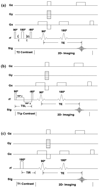
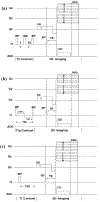
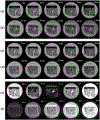
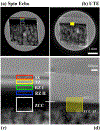
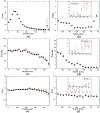
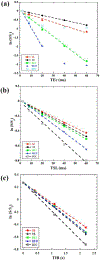
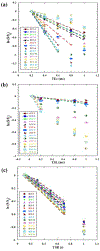
Similar articles
-
The interface region between articular cartilage and bone by μMRI and PLM at microscopic resolutions.Microsc Res Tech. 2022 Apr;85(4):1483-1493. doi: 10.1002/jemt.24011. Epub 2021 Dec 3. Microsc Res Tech. 2022. PMID: 34859542 Free PMC article.
-
Dual inversion recovery ultrashort echo time (DIR-UTE) imaging and quantification of the zone of calcified cartilage (ZCC).Osteoarthritis Cartilage. 2013 Jan;21(1):77-85. doi: 10.1016/j.joca.2012.09.009. Epub 2012 Sep 28. Osteoarthritis Cartilage. 2013. PMID: 23025927 Free PMC article.
-
Assessment of mechanical properties of articular cartilage with quantitative three-dimensional ultrashort echo time (UTE) cones magnetic resonance imaging.J Biomech. 2020 Dec 2;113:110085. doi: 10.1016/j.jbiomech.2020.110085. Epub 2020 Oct 24. J Biomech. 2020. PMID: 33147490 Free PMC article.
-
[Image assessment of the cartilage and subchondral bone in patients with osteoarthritis].Clin Calcium. 2011 Jul;21(7):981-91. Clin Calcium. 2011. PMID: 21719978 Review. Japanese.
-
Articular Cartilage Assessment Using Ultrashort Echo Time MRI: A Review.Front Endocrinol (Lausanne). 2022 May 26;13:892961. doi: 10.3389/fendo.2022.892961. eCollection 2022. Front Endocrinol (Lausanne). 2022. PMID: 35692400 Free PMC article. Review.
Cited by
-
Chemical Profiling and Quality Assessment of Food Products Employing Magnetic Resonance Technologies.Foods. 2025 Jul 9;14(14):2417. doi: 10.3390/foods14142417. Foods. 2025. PMID: 40724238 Free PMC article. Review.
-
Histological Grade and Magnetic Resonance Imaging Quantitative T1rho/T2 Mapping in Osteoarthritis of the Knee: A Study in 20 Patients.Med Sci Monit. 2019 Dec 27;25:10057-10066. doi: 10.12659/MSM.918274. Med Sci Monit. 2019. PMID: 31881548 Free PMC article.
-
Magic angle effect on diffusion tensor imaging in ligament and brain.Magn Reson Imaging. 2022 Oct;92:243-250. doi: 10.1016/j.mri.2022.06.008. Epub 2022 Jun 28. Magn Reson Imaging. 2022. PMID: 35777687 Free PMC article.
-
Ultrashort echo time magnetic resonance imaging of the osteochondral junction.NMR Biomed. 2023 Feb;36(2):e4843. doi: 10.1002/nbm.4843. Epub 2022 Nov 20. NMR Biomed. 2023. PMID: 36264245 Free PMC article. Review.
-
T2*-Mapping of Knee Cartilage in Response to Mechanical Loading in Alpine Skiing: A Feasibility Study.Diagnostics (Basel). 2022 Jun 4;12(6):1391. doi: 10.3390/diagnostics12061391. Diagnostics (Basel). 2022. PMID: 35741201 Free PMC article.
References
-
- Maroudas A, Physicochemical properties of articular cartilage, in: Freeman MAR (Ed.) Adult articular cartilage, 2nd ed, Pitman Medical, Kent, England, 1979, pp. 215–290.
-
- Buckwalter J, Mankin H, Articular Cartilage Repair and transplantation, Arthritis & Rheumatism, 41 (1998) 1331–1341. - PubMed
-
- Bullough PG, Yawitz PS, Tafra L, Boskey AL, Topographical variations in the morphology and biochemistry of adult canine tibial plateau articular cartilage, J Orthop Res, 3 (1985) 1–16. - PubMed
-
- Hoemann CD, Lafantaisie-Favreau CH, Lascau-Coman V, Chen G, Guzman-Morales J, The cartilage-bone interface, The journal of knee surgery, 25 (2012) 85–97. - PubMed
-
- Redler I, Mow VC, Zimny ML, Mansell J, The Ultrastructure and Biomechanical Significance of the Tidemark of Articular Cartilage, Clin. Orthop. and Related Topics, 112 (1975) 357–367. - PubMed
Publication types
MeSH terms
Grants and funding
LinkOut - more resources
Full Text Sources
Medical

